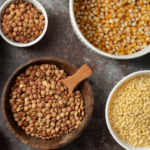For centuries, millets have been a staple food in many cultures across Asia, Africa, and parts of Europe. Known as “ancient grains,” these small-seeded grasses sustained communities long before polished rice and refined wheat dominated our plates. Today, millets are experiencing a remarkable revival. From organic stores in New York to wellness cafés in Bangalore, these humble grains are being rediscovered as the ultimate superfood. But what’s driving this global comeback? Let’s explore.
1. A Powerhouse of Nutrition
Millets are naturally gluten-free, rich in fiber, and loaded with essential vitamins and minerals. Compared to refined grains, they offer:
- Higher protein content to support muscle health
- Abundant antioxidants that help fight free radicals
- Iron, calcium, and magnesium for stronger bones and improved immunity
- Low glycemic index, making them ideal for people managing diabetes
In an era where people are moving towards clean eating and whole foods, millets stand out as both nutritious and versatile.
2. Sustainability and Climate Resilience
One of the biggest reasons behind the millet revival is their environmental advantage. Unlike water-intensive crops like rice and wheat, millets require minimal irrigation and thrive in arid soils. They are hardy grains that can withstand extreme weather conditions, making them crucial in the fight against climate change and global food insecurity. Governments and international organizations are actively promoting millets as a sustainable solution to feed growing populations without straining natural resources.
3. Rediscovering Culinary Heritage
For many, millets evoke nostalgia—dishes like ragi mudde in Karnataka, bajra rotis in Rajasthan, and foxtail millet porridge in parts of Africa connect people to their cultural roots. This culinary heritage is now being reintroduced in modern forms. Think millet-based breakfast cereals, energy bars, pastas, and even craft beers. Chefs and food entrepreneurs are blending traditional wisdom with innovation, making millets appealing to younger generations worldwide.
4. The Global Wellness Movement
As the wellness industry expands, consumers are prioritizing foods that improve digestion, balance weight, and boost immunity. Millets fit perfectly into this narrative. Fitness enthusiasts and nutritionists recommend them as an alternative to refined carbs. Their high fiber content not only keeps hunger at bay but also supports gut health—a growing focus in the global health community.
5. Recognition on the World Stage
The year 2023 was declared the International Year of Millets by the United Nations, further highlighting their importance. This recognition has accelerated global awareness, encouraging farmers, policymakers, and brands to integrate millets into mainstream diets. As a result, millet-based products are increasingly available in supermarkets across the world.
Conclusion: The Grain of the Future
Millets are more than just a passing trend—they represent a return to wholesome traditions that align perfectly with modern needs for health and sustainability. As people across the globe seek balanced diets and eco-friendly choices, millets are stepping into the spotlight. From ancient kitchens to contemporary menus, their journey proves that sometimes, the answers to the future lie in the wisdom of the past.
So, the next time you choose your grains, consider a bowl of millet. Not only are you nourishing your body, but you’re also making a conscious choice for the planet.




